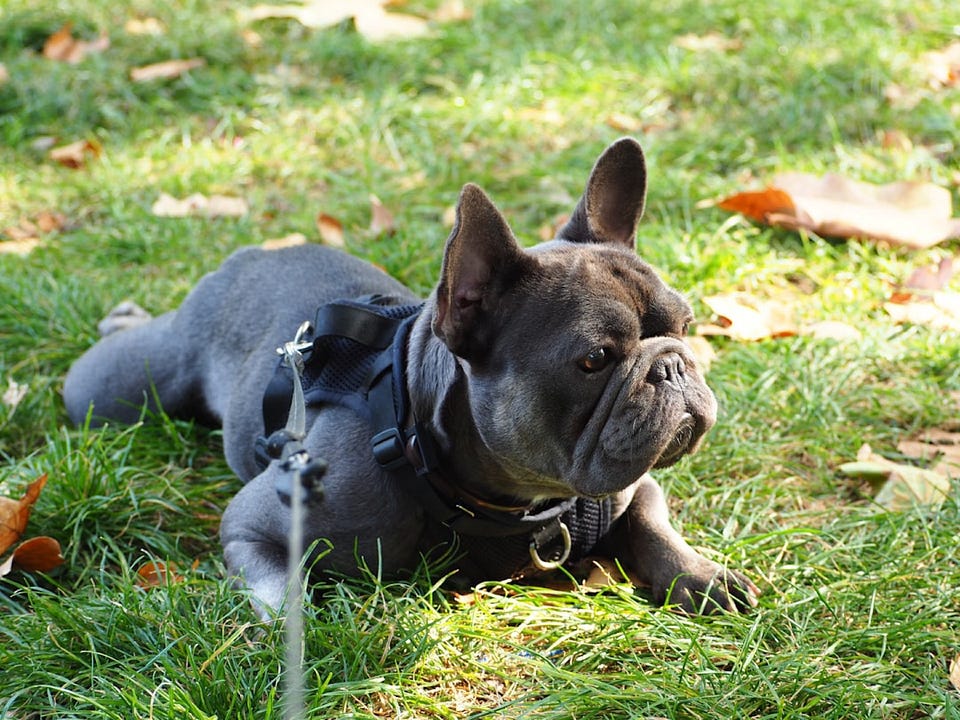There’s rarely one big moment that makes it clear your pet is ready to go. However, over time, physical and emotional changes can begin to point towards a decline in quality of life. This article outlines the most common signs that it might be time to say goodbye, tools to help assess your pet’s comfort, and what to expect during the process — written by someone with experience in both veterinary medicine and end-of-life decision-making for her own pet and saying goodbye to a dog.
Let’s Talk About “The Time” No One Wants To Face
As pet parents, we’re never fully prepared to make end-of-life decisions, even when we know our pets are aging or in delicate health. Whether your pet is battling a chronic condition or simply slowing down in ways that feel unfamiliar, figuring out when it’s time can feel almost impossible.
I’m currently facing this with my own dog, Frank, my 11-year-old rescue Frenchie. He’s had a lifetime of health issues: digestive problems, difficulties with mobility, seizures, a missing eye… you name it. But despite all of that, he’s always been full of personality, affection, and resilience.
Lately, though, things have shifted. He’s losing weight. He forgets where he is, often wandering the house at night. He struggles more to get up, and his spark — the one thing that’s carried him through so much — is dimming. It’s been a slow decline and the hardest part is realizing when he’s not really living anymore — just existing.
If you’re in that same space, I hope this helps you sort through the fog of guilt, love, and uncertainty that comes with making this decision.

Signs It Might Be Time to Let Go
Every pet is different, and every journey is personal. But these are some of the most common indicators that your pet’s quality of life may be declining beyond what can be comfortably managed:
- Loss of appetite
- Mobility Struggles
- Incontinence or bathroom accidents
- Confusion or signs of cognitive decline
- Loss of interest in people, toys, or routine
- Visible signs of pain and/or discomfort
Some pets start to quietly “check out” when their bodies are failing — refusing food, ignoring their favorite person, or sleeping through the day. If you’re noticing these emotional shifts alongside physical decline, it may be time to start the conversation with your vet.
Using a Quality of Life Scale
If you’re struggling to gauge how your pet is really doing, tools like the Lap of Love Quality of Life Scale or the HHHHHMM Scale can help.
Ask Yourself:
- Are the good days still outnumbering the bad?
- Are they still enjoying their time with you?
- Are they physically and emotionally comfortable?
Did You Know? It’s very common for pet parents to wait too long to say goodbye — not too early. If your pet is uncomfortable more often than not, choosing peace isn’t giving up. It’s giving them the dignity they deserve.
Considering In-Home Euthanasia
This is an option that offers a peaceful and comfortable environment for your pet’s final moments.
In-home euthanasia can be especially comforting for families who want privacy and a quiet goodbye. Your vet may offer this, or you can contact mobile euthanasia services like Lap of Love, which specializes in compassionate, in-home end-of-life care. These visits are usually scheduled in advance, and many providers offer aftercare options.
Did You Know? This service isn’t just for emergencies or large dogs. It’s a great option for pets who are easily stressed by travel or vet visits and also for parents who want a more personal, familiar setting.

Preparing for Their Final Goodbye
Once the decision is made for saying goodbye to your dog, a little preparation can go a long way in creating a peaceful experience for both your pet and your family
- Talk openly with your vet. Ask what the process looks like, what medications are used, and how your pet will likely respond. If you’re unsure whether it’s time, say, “I need help figuring out if we’re close”. That opens the door for the conversation.
- Decide on the setting. Choose what feels right for you, whether that’s at your vet’s office or at home. Some clinics offer private rooms or “comfort rooms” with couches and soft lighting. They might also allow you to bring items from your home.
- Plan what (and who) you want there. Decide if you’d like to be present during the euthanasia or say goodbyes beforehand. Some people invite close friends, partners or even allow other pets to be there. There’s no wrong choice.
- Aftercare matters, too. Talk about cremation, memorial keepsakes, or burial options in advance if you can. Having a plan for these kinds of things can ease some emotional weight afterward. I’ve seen many clients too distraught to speak about these things after the process.
- Give yourself some grace. Whatever you’re feeling — relief, guilt, confusion, numbness — it’s normal. You’re doing something incredibly hard with so much love behind it.
Saying Goodbye to a Dog From The Other Side Of the Table: A Vet Tech’s Perspective
As someone who’s worked in veterinary medicine for years, I’ve walked alongside dozens of families making this call. I’ve seen the signs. I’ve explained the options. I’ve been there when it’s time, and I’ve held the space for the grief that comes after.
That experience has helped me guide others, but it hasn’t made this easier with Frank — I’m human, too. What it has shown me is that most pet parents don’t need a “right answer”; they need the reassurance that they’re not doing this alone.
Final Thoughts on Saying Goodbye to a Dog
There’s no one-size-fits-all answer for when it’s time. But if your gut keeps circling back to the question: “Are they still comfortable? Are they still happy?”, then you already care enough to be making this decision thoughtfully.
Sometimes, you don’t have to wait for your pet to give a clear “sign”. Sometimes, the clearest sign is your own quiet knowing that they aren’t themselves anymore. And that’s more than enough.
Trust your heart and trust your pet. When it’s time, you’ll be giving them the gentlest gift you can.

For Frank
Thank you for being my first big girl dog at your big dog age. I always wanted a Frenchie, but never for as short as this.
You loved people, even though you couldn’t see them half the time. Always down for a cuddle, but god-forbid I stopped petting you. Your farts could clear a room, but your crooked smile brought everyone right back.
You made me slow down with you, and I enjoyed every second of it. Thank you for letting me give you a good final home — I hope they have all the tennis balls up there for you.
Love, Bryanna and your brother Bruno 🐾❤️🎾
Sources and Further Reading on Saying Goodbye to a Dog
- VCA Animal Hospitals. Urinary Incontinence (Urethral Incontinence) in Dogs
- PetMD. Dog Dementia: Symptoms, Causes, Treatment, and Life Expectancy
- Lap of Love Quality of Life Scale
- Caring Pathways. HHHHHMM Scale
- Lap of Love website
Additional Resources for Support
- Grief Healing. List of pet loss support hotlines
- Lap of Love. Pet Loss Support Group
- Letters to Pushkin. Healing through expression and writing. You can write directly to your pet, upload a photo, and make these public for others to see.




